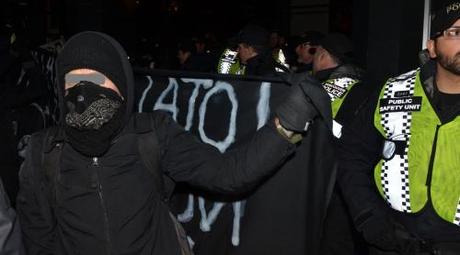
by Zig Zag, Warrior Publications, January 15, 2013
As many as 1,000 people gathered in downtown Vancouver on Monday, Jan 14, 2013, to protest the Enbridge hearings. Organized by Rising Tide and a coalition of community groups, the demonstration occurred on the first evening of hearings held by the National Energy Board’s joint review panel in the city. Citing security reasons, the panel hearings are closed to the public and only those who have registered to make submissions are allowed entry.
The initial rally point was at Victory Square, a dimly lit park in downtown Vancouver. The weather was cold and rainy, at times snowing. Many of the speakers were Indigenous people, including an opening statement and prayer by local Coast Salish people, as well as some participants in the recent Idle No More rallies.
It was at this time that I noticed a group of perhaps 25 people dressed in all-black clothing and wearing masks. The Vancouver police attending the rally point also seemed to notice them at this time, for soon there were an equal number of cops standing in groups around the black-clad protesters. These were members of the ‘Public Safety Unit’ (PSU), used by Vancouver police for crowd control.
After several speeches and drum songs, the rally moved onto Cambie Street and began moving west on Hastings, towards the Sheraton Wall Centre, a hotel complex in downtown Vancouver where the Enbridge hearings were occurring. At this point, people had been gathered for nearly 1.5 hours.
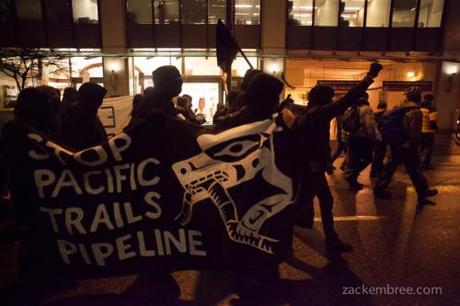
As the demonstration began moving, the black bloc was covered on the sides and rear by the PSU cops, including two who held a video camera and attempted to film the militants. The banners carried by the bloc participants were held high enough to neutralize most of the video recording, and at times a black flag was draped in front of the lens. The banners were also used to keep the cops out of the bloc itself.
The march covered many city blocks, with sections chanting different slogans at times, while at the front mostly Native women led the way with drumming and singing. When it finally reached the Sheraton, it flowed into the central plaza inside the hotel complex. The black bloc moved directly in front of the lobby doors, where more cops from the PSU were deployed (in a line blocking the entrance). Initially there were perhaps 30 cops, but this number swelled to as many as 40-50.
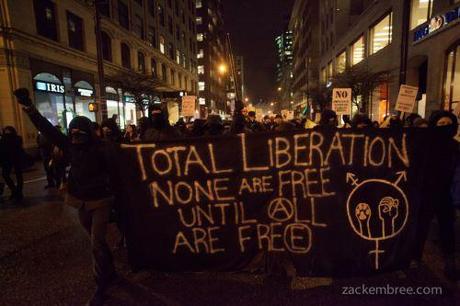
While the crowd chanted slogans such as “No Pipelines on Stolen Native Land,” the black bloc maintained their position in front of the lobby. They held their banners up to obstruct the view of a large section of the PSU cops, while occasionally hurling insults at them (such as “Fuck the Police”).
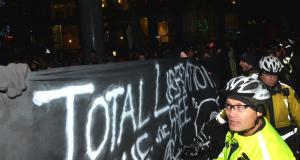
Adjacent to the bloc and extending the line of the protesters across the lobby entrance were Natives, who stood with their backs to the police while drumming and singing.
After the rally had occupied this space for 30 minutes or so, it was announced that we were at the wrong building, so the mob moved through the plaza to another one. There were no cops here at all, and it was pretty obvious that this was the “wrong” building. After ten minutes, we moved back to the original lobby, where the PSU remained in position. The black bloc also resumed its original position directly in front of the police.
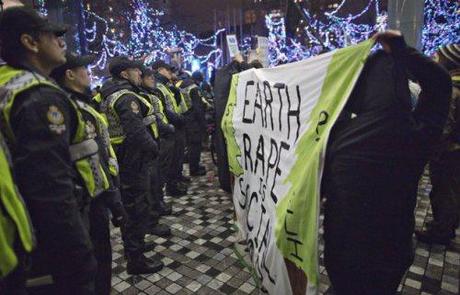
More speeches were made, many by Natives, along with more drumming and singing. After another 45 minutes or so, the black bloc took down their banners and moved in a single file into the crowd, where it dispersed and participants removed their outer layer of black clothing. According to one participant, they did this because the crowd was beginning to get smaller and would provide less concealment as more time passed.
Black Bloc methods and tactics
Contrary to the claims of some, these militants were not “agents provocateurs,” nor did they attempt to instigate any attacks on police or property. In fact, they conducted themselves as a defensive force. At the rally point in the park and during the march through the streets, they attracted the attention of police and drew a number of them away from other protesters. At the hotel lobby, they positioned themselves in front of the police and established a line between the cops and other protesters.
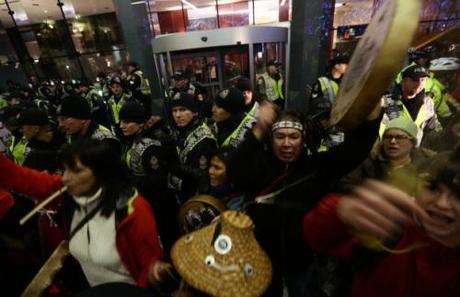
This is not to say that the black bloc are not capable of attacking police or property, however. It is clear from the response of the police that the bloc is the only contingent in the protest they consider to have a defensive-offensive capability, which is why they congregate their forces around any assembled bloc. The black bloc tactic has also shown itself capable of carrying out considerable property destruction and street fighting with police, including protests against the World Trade Organization in Seattle 1999, the 2001 Quebec City protests against the Summit of the Americas, and more recently the Toronto G20 of 2010.
The term black bloc first emerged in West Germany during the early 1980s and referred to the practice of militant autonomists dressing in all-black clothing as a means of countering police surveillance & repression. They marched together in blocs to defend mobilizations against police attacks, and to also attack corporate property.
Generally, black blocs are comprised of radicals who see no hope in reforming the capitalist system. Many advocate an anarchist society that is based on autonomy and decentralization, with no centralized authority (such as a state government). In other words, they share a similar method of self-organization that many traditional Indigenous societies are based on.
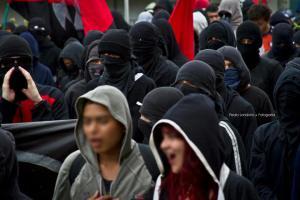
Many people accept the police and corporate media accounts of black blocs as mindless hooligans and thugs, while some continue to perpetuate conspiracy theories that they are comprised of undercover cops, sent in to start riots in order to undermine “peaceful” protests.
In the only documented case of undercover cops attempting to infiltrate a rally, which occurred during protests in Montebello, Quebec, in 2007, it was masked militants who first identified them. Later, the Quebec provincial police admitted that the three were in fact cops.
In reality, the black bloc are comprised of committed radicals who work on many different projects, such as bookstores, soup kitchens, community gardens, social centres, etc. They also organize protests and solidarity campaigns, frequently with Indigenous peoples (in Canada).
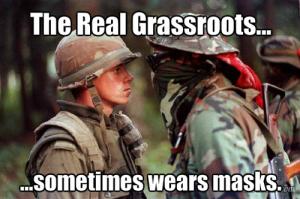
In the context of non-Native settler social movements in this country, the black bloc displays a fighting spirit that is otherwise sorely lacking. Their uncompromising and confrontational attitude is a far clearer manifestation of resistance than the standard passive protests that routinely occur in North America, and which often serve to disarm people psychologically and reaffirm the illusion of the “democratic” state.

Nor are the militant methods of the black bloc so far removed from those used by militant Natives. During the Oka Crisis of 1990, the image of the warrior as a masked and uniformed fighter came to symbolize Indigenous resistance, along with the Mohawk Warrior flag. Ever since then, it has been common to see Native warriors wearing masks, and frequently in combat uniforms, at blockades and occupations.
As socio-economic conditions continue to decline, and as Native peoples continue to mobilize to defend their lands and people in the face of state repression, there is a lot that can be learned from the black bloc, who have accumulated over 3 decades of experience in direct actions and overcoming increasingly repressive police tactics. These include the necessity of wearing proper disguise when committing “illegal” activities (due to the presence of cameras), being able to disperse and escape police cordons, detecting and avoiding police containment (‘kettles’), defending against chemical agents (such as tear gas and pepper spray), etc.
For more info on the black bloc:
Can’t Stop Kaos
A brief intro to the history and practice of the infamous Black Bloc, from its origins among the German autonomists to its development in N. America.
http://militantz.wordpress.com/2012/05/03/zine-cant-stop-kaos/
10 Points on the Black Bloc
A pamphlet based on a public talk given by Harsha Wallia of No One Is Illegal.
http://militantz.wordpress.com/2012/04/02/10-points-on-the-black-bloc-2/
Black Bloc Papers
The Black Bloc Papers: An Anthology of Primary Texts From The North American Anarchist Black Bloc 1999-2001 The Battle of Seattle (N30) Through Quebec City (A20)
A large collection of Black Bloc communiques, reports, and analysis. Published by the Green Mountain Anarchist Collective.
http://militantz.wordpress.com/2012/04/25/black-bloc-papers/

